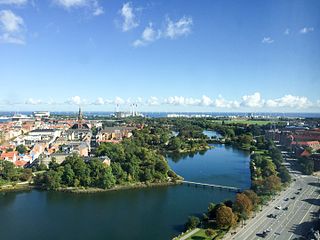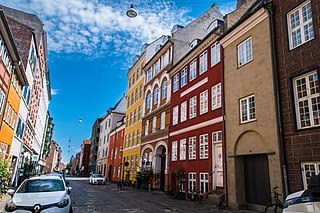
Freetown Christiania, also known as Christiania, is an intentional community, commune and micronation in the Christianshavn neighbourhood of the Danish capital city of Copenhagen. It began in 1971 as a squatted military base. Its Pusher Street is famous for its open trade of cannabis, which is illegal in Denmark.

Indre By, also known as Copenhagen Center or K or Downtown Copenhagen, is an administrative district (bydel) in central Copenhagen, the capital of Denmark. It covers an area of 4.65 square kilometres (1.80 sq mi), has a population of 26,223, and a population density of 5,638 per km².

Christianshavn is a neighbourhood in Copenhagen, Denmark. Part of the Indre By District, it is located on several artificial islands between the islands of Zealand and Amager and separated from the rest of the city centre by the Inner Harbour. It was founded in the early 17th century by Christian IV as part of his extension of the fortifications of Copenhagen. Originally, it was laid out as an independent privileged merchant's town with inspiration from Dutch cities but it was soon incorporated into Copenhagen proper. Dominated by canals, it is the part of Copenhagen with the most nautical atmosphere.

Sundbyøster is one of the 15 administrative, statistical, and tax city districts (bydele) comprising the municipality of Copenhagen, Denmark. It lies on the southeast border of the municipality on the island of Amager. It covers an area of 8.60 km2, has a population of 48,673 and a population density of 5,658 per km2, which makes it the most populated district in Copenhagen.

Islands Brygge is a harbourfront area in central Copenhagen, Denmark, located on the north-western coast of Amager. The neighbourhood is noted for its waterfront park Havneparken, which is one of the most popular areas along the Copenhagen harbourfront and the location of one of the Copenhagen Harbour Baths.
Amager Øst is one of the 10 official districts of Copenhagen, Denmark. It encompasses the part of Copenhagen located on the island of Amager, east of the major shopping street Amagerbrogade.Prior to an administrative reform in 2006–08, the district was known as Sundbyøster.

The fortifications of Copenhagen underwent a comprehensive modernization and expansion in the 17th century. The project was commenced and was largely the masterplan of Christian IV in the early 17th century but was continued and completed by his successors. The new fortifications relied on the existing, medieval fortifications of the city but the fortified area was extended and a defensive ring around the city completed particularly with new edifices facing the sea. The ring fortification consisted of four bastioned ramparts and an annexed citadel as well as various outworks.

The Fortification Ring in Copenhagen, Denmark, is a collective name used to refer to the grounds where the city's old 17th-century fortifications used to lie, now surrounding the City Centre. Since the fortifications were decommissioned in 1870, the Fortification Ring has been dominated by a number of parks and distinctive greenspaces and it is still maintained and developed as a green belt within the city limits, running between the city centre and the -bro districts. The ramparts, bastions and moats of the former fortifications are still clearly seen in the topography. At Christianshavn and the citadel Kastellet, the fortifications have been preserved and remain intact.

Langebro is a bascule bridge across the Inner Harbour of Copenhagen, Denmark, connecting Zealandside H. C. Andersens Boulevard to Amagerside Amager Boulevard. It is one of only two bridges to carry motor vehicles across the harbour in central Copenhagen, the other being Knippelsbro.

Christianshavns Vold is a former rampart which was part of the bastioned fortification ring which used to surround Copenhagen, Denmark. Running along the full south-eastern perimeter of Christianshavn and Holmen, it used to form a protective barrier towards the island of Amager. It consists of earthworks with 12 bastions and in front of it ran a moat, Stadsgraven, now forming a broad canal which separates Christianshavn from the rest of Amager. On the other side of Stadsgraven. on Amager, was a lower system of outworks called Christianshavns Enveloppe of which only the northern half survives. Along with Kastellet on the other side of the harbour, it is the only intact part of the fortification system.

Dyssebroen is a pedestrian and cycle bridge located in the area known as Freetown Christiania in Copenhagen, Denmark. It connects the Christianshavn Side main portion of the community to its more 'rural' Amager Side backdrop across Stadsgraven, the former moat of the Christianshavn Rampart which formed part of the Bastioned Fortification Ring which used to guard the city.

Stadsgraven is the canal which separates Christianshavn from the rest of Amager in Copenhagen, Denmark. It was originally a moat located in front of the Christianshavn Rampart as part of the city's Bastioned Ring Fortifications.

Jacob Holm was a Danish industrialist, ship owner and merchant. He founded the company Jacob Holm & Sønner, which still exists today.

Applebyes Plads is a triangular area located between Langebro Bridge and the southernmost portion of Christianshavn Canal at the southern tip of the Christianshavn neighbourhood in Copenhagen, Denmark. The area takes its name from Peter Applebye, Christian VI's rope maker, who ran his manufactury from the site in the late 18th century, although no buildings remain from that time. The Danish Sugar Factories' building along the waterfront dates from 1912 while the rest of the grounds have undergone residential redevelopment in later years.

Torvegade is the central thoroughfare of Christianshavn in Copenhagen, Denmark, linking the city centre by way of Knippel Bridge with Amagerside Copenhagen at Christmas Møllers Plads. The street crosses Christianshavn Canal at Christianshavns Torv, the central square of the neighbourhood. The last section of the street runs on the embankment that across Stadsgraven.

Wildersgade is a street in the Christianshavn district of Copenhagen, Denmark. It runs along the length of the neighbourhood, parallel to Christianshavn Canal, one block to the east, from the Christiansbro development in the south(west) to Wilder's Canal in the north(east). The street is bisected by Torvegade, Christianshavn's principal thoroughfare, but is otherwise a quiet mainly residential street with cobbling and many old townhouses and storages from the 18th and 19th century.
Sofiegade is a street in the Christianshavn neighbourhood of central Copenhagen, Denmark. It runs from Christianshavns Kanal in the northwest to Christianshavns Voldgade and Christianshavns Vold in the southeast, passing Dronningensgade and Prinsessegade on the way.

Amager Boulevard is a street on Amager in Copenhagen, Denmark. It begins at Langebro Bridge and initially follows Stadsgraven east to a Y-junction from where it continues inland to Amagerbrogade while the street Ved Stadsgraven continues along the water to the Christmas Møllers Plads.

Christmas Møllers Plads is a major junction located in front of the embankment to Christianshavn on northern Amager in Copenhagen, Denmark. It links Torvegade, the main thoroughfare of Christianshavn, with Vermlandsgade, Amagerbrogade, Amagerfælledvej and Ved Stadsgraven-Amager Boulevard. Its name commemorates the Conservative politician Christmas Møller who had been active in the resistance movement during World War II and later served as Minister of Foreign Affairs.

Torvegade 22 is an 18th-century property situated on Torvegade in the Christianshavn neighborhood of central Copenhagen, Denmark. The building was from its construction in 1714 to 1902 owned by bakers and the site of one of two bakeries in the street. A gilded kringle can still be seen above the main entrance. The other bakery was situated a little further down the street at Torvegade 28. The building was listed in the Danish registry of protected buildings and places in 1950.



















